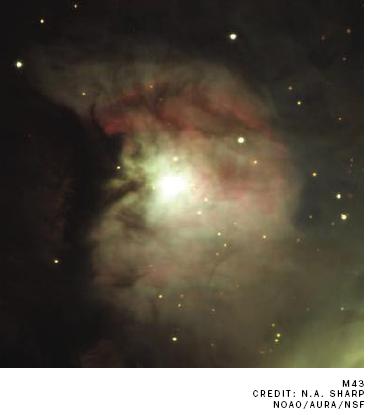The Institute

As stars are born when gas clouds found in interstellar space contract and collapse in on themselves as a result of their own gravity. The gas cloud collapsing into itself becomes more compressed and hotter, until nuclear fusion processes begin to take place in it that convert matter into energy (something that manifests itself in radiation - such as the radiation of "our" sun - that bursts from the star into its environment).
On the one hand, it is known that compressing a gas causes it to heat up, which means increasing the speed of the atoms and molecules that make it up. But on the other hand, when the atoms and molecules move at an increasing speed, and when their density increases (due to the contraction), the pressure and temperature of the material also increase, which makes it difficult - and ultimately prevents - the continuation of the contraction process. If indeed this were the case, there would never have been stars in the universe. But as we know, the universe contains billions of stars. How, then, are the stars formed? What allows them to continue to contract even when their temperature rises?
Scientists who investigated this question came to the conclusion that in the gas clouds that become stars, a kind of cooling system operates that cools the compressed material and allows it to continue to compress, until the point where the gravitational energy of the contracting material can overcome the counter pressure (expressed in the temperature of the material).
The popular concept in this regard says that the cooling system of the stars that are formed and go away is based on a process that begins when the kinetic energy of the gas is converted and used to excite the gas molecules. In the second stage, the excited gas molecules emit the excitation energy (in the form of radiation) into outer space. The most important molecule in this process is the water molecule. But here a new difficulty arose: the attempts to detect water in the interstellar gas clouds did not go well (due to interference in the observation caused by the water found in the Earth's atmosphere).
Therefore, the scientists began to look for indirect ways to prove the existence of water in the stars, for example, to discover the existence of substances that may serve as "stations" in the process of the formation of water (a water molecule contains one oxygen atom and two hydrogen atoms). One such possible "station" is the substance called "hadronium", whose molecule contains one oxygen atom and three hydrogen atoms (hadronium - unlike water - can be detected using telescopes placed on the surface of the earth). The question is, is this possibility actually realized in reality? Is water really formed in the stars? And are they created as a result of reactions involving dronium?

Dr. Daniel Zeifman, Weizmann Institute
Dr. Daniel Zeifman and Dr. Oded Haber from the Department of Particle Physics at the Institute, who sought to answer these questions, designed and performed an experiment that simulates the physical and chemical conditions prevailing in interstellar clouds.
The experiment was carried out in collaboration with researchers from Aarhus University in Denmark, using a facility called "Ion Storage Ring". In the experiment, the researchers showed that indeed, water is formed in the interstellar clouds in a reaction that takes place between a single electron and a hadronium.
From the results of the experiment it becomes clear that in the interstellar clouds there is a constant ratio between the amount of hadronium and water.
Observations and calculations based on the findings of the experiment, the results of which were published in the prestigious scientific journal "Physical Review Letters", have already shown that water is indeed the factor that allows the contracting gas clouds to release heat radiation into the interstellar medium, in the process of turning into stars. The American research satellite "SAWS", which will be launched in the coming months, will once again examine the research findings of the institute's scientists. This satellite will carry special measuring instruments, which will measure the amount of water found in interstellar gas clouds.
Yadan Astrophysics 6 - A star is born
https://www.hayadan.org.il/BuildaGate4/general2/data_card.php?Cat=~~~433004619~~~70&SiteName=hayadan
